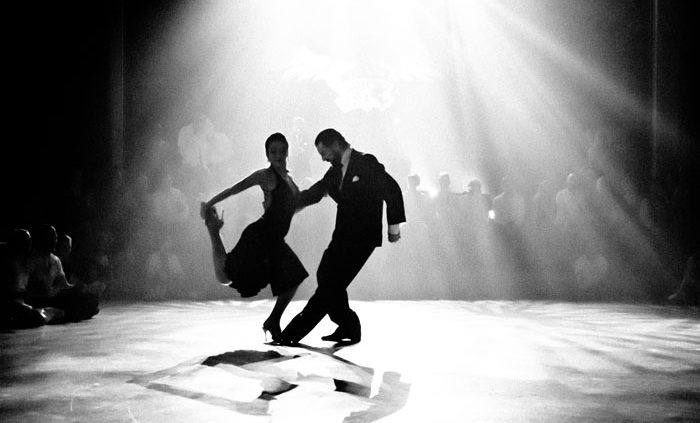Tango: A Story of Connection
By: Sharna Fabiano, UCLA World Arts & Cultures
Tango has long suffered from an international identity crisis. Erotic images typify the portrayal of tango in popular media, but curiously, experienced social dancers tend to liken tango to mind-body practices like yoga or martial arts, highlighting experiences of connection and creative flow. My own involvement with tango began in Cambridge, MA, in 1997, when I discovered the massive chasm between commercial and social tango, two related, yet unrelated, dance forms that irritate but cannot completely avoid one another. It is the community-based tradition of social tango that I have spent the last 15 years studying and teaching, and that I believe fosters the overall health and well-being of those who practice it.
A successful tango on the dance floor is one in which information flows back and forth, replacing the perception of two with the awareness of one. Tango partners listen and respond to one another, improvising each dance in the moment. This experience of generous, collaborative partnership makes dancers feel good about themselves by strengthening their sense of connection to others.
The tango classes offered in World Arts & Cultures/Dance are a wonderful opportunity to generate a sense of belonging in a group of students from across the entire campus, not only within the dance major. Requiring no previous experience, tango has a largely pedestrian technique. The goal for a tango dancer is not to be the same as anyone else, but to find a unique, personal way of expressing the form. In addition to being accessible, tango improves posture, balance, and coordination by gradually discovering more efficient ways of executing specific movements. Since these movements are always performed in relation to a partner, tango also teaches respect, and safe, supportive ways to approach physical touch. In their improvising, tango dancers learn to transmit trust, reliability, enthusiasm, confidence, playfulness, and patience to their partners through their own physical presence. In all of these ways, the practice of tango cultivates important communication skills that may be transferred to professional, academic, or personal contexts.
Furthermore, in this tango course, all students learn both following and leading roles, breaking the gender codes normally associated with partner dances. Learning both roles is not only a profound educational experience, but it also reinforces the understanding that both women and men are “followers” and “leaders” in the world, and that the relationship between followers and leaders can be complementary rather than hierarchical.
As an MFA student at UCLA, I’ve spent the last three years excavating tango for new choreographic tools. My degree concert, “After Hours,” is a series of interactions among four employees of a tango club, very late at night. But there is no classic tango, per se, in this show. Rather, tango principles such as lead-and-follow and upper body vs lower body direct the movement. I hope that audiences receive some of the experience of connection that I know to be so powerful for the participants of social tango dance. At the very least, this will be a very different idea of tango performance than the one presented in mainstream media!
The Dept. of World Arts & Cultures/Dance MFA Upstarts Series presents:
After Hours
Date: Fri, April 25, 2014
Time: 8:00PM Venue: Glorya Kaufman Hall, Room 200, UCLA Ticket price: $15/$8 students
Dance with us during Summer Session 2014!
Dance 8: Beginning Tango
Session A: Jun 23 – Aug 01, MWF, 1-2:30pm
Session C: Aug 04 – Sep 12, MWF, 1-2:30pm



